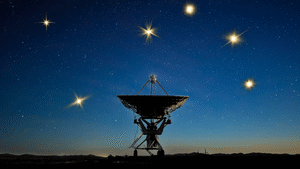Space is really, really big. And that makes it really, really hard to search for aliens. So many stars, planets and weird interstellar objects; so little time.
A team led by University of Toronto astronomer Peter Ma wants to speed up our hunt for E.T. and make space feel a little smaller. The plan, which Ma and his coauthors outlined in a peer-reviewed study published in Nature on Monday, is to deploy a very clever form of artificial intelligence that can analyze petabytes of data—that’s thousands of terabytes—way faster than any person ever could.
“We want to develop algorithms and techniques that allow us to effectively explore our many petabyte datasets,” Ma told The Daily Beast. “This helps us cast a wider net.”
There’s at least one potential problem, however. Algorithms are only as intuitive as their creators. And SETI requires a lot of intuition.
We look for extraterrestrials in a lot of different ways: peering at nearby planets with our most powerful telescopes, scrutinizing weird interstellar objects just in case they’re alien probes, and even inspecting meteorites on the off chance they contain embedded scraps of long-defunct alien technology.
But the most important method in SETI is one of the oldest. Since the 1960s, astronomers have pointed sensitive radio receivers at the sky, recorded countless hours of seemingly random space noise then sifted through the resulting reams of data looking for patterns.
If a noise is really loud, repeats at regular intervals or includes signal patterns hinting at logic and language, it might be alien chatter—the first hard evidence that we’re not alone in the universe.
The problem with radio SETI is that space is vast, and our brains are small. Pointing one of the world’s many large radio telescopes at some interesting sector of space—one with a sun-like dwarf star, for instance—for even a few hours might generate hundreds of pages of figures translating the beeps, chirps and groans of deep-space radiation.
For decades, it was the sole job of human beings to look for patterns in those figures. It was grueling work, and rife with potential error. It’s even possible that we’ve detected alien signals already… and simply have not noticed.
Take the so-called “Wow!” signal. One night in August 1977, Ohio State University astronomer Jerry Ehman was scrutinizing readouts from a recent radio survey, in the direction of the Sagittarius constellation, when he noticed what seemed like a really loud burst of noise—and one with a seemingly symbolic frequency: 1,420 megahertz, the resonant frequency of an energized hydrogen atom.
Ehman felt it might be a possible message from outer space. “Wow!” he scrawled on the data print-out.
Belated efforts to capture the same sound a second time came to nothing. Maybe astronomers waited too long to listen again. Maybe the signal changed slightly and the scientists couldn’t separate it from the random groans of space radiation. Maybe it was never really anything special.
In any event, the Wow! signal faded into history until, last summer, Columbia University astronomer David Kipping and Chicago data consultant Robert Gray tried to make the case for another survey of the same sector where Wow! originated.
“Either we spend two months on the Wow! field and see nothing and can then move on, or we see a recurrence—and that would change the whole story,” Kipping and Gray wrote in their peer-reviewed study, which appeared last year in the science journal Monthly Notices of the Royal Astronomical Society.
But another attempt to listen for the Wow! signal remains a low priority. Part of the problem is that an intensive radio survey can cost millions of dollars. “Extraordinary evidence requires extraordinary funding,” Harvard physicist Avi Loeb, a big proponent of the search for aliens, told The Daily Beast.
One of the reasons it’s so expensive is that it’s manpower-intensive. While the process gets more automated every year, people still do much of the work of analyzing space noise for possible snippets of E.T.’s conversation. That’s right—our search for extraterrestrial intelligence has a manpower problem. “We’re in an age where there is more data than we can process,” Ma said.
A smart, self-teaching A.I. might help. Ma and his coauthors tested the hypothesis by creating a “novel β-convolutional variational autoencoder”—basically, a complex computer algorithm, modeled on human neural pathways, that’s capable of recognizing vague patterns in messy data.
As a bonus, the algorithm improves its pattern-recognition by remembering how it found previous patterns. “This machine-learning approach presents itself as a leading solution in accelerating SETI,” Ma and his co-authors wrote.
They gave the A.I. a moderately difficult task, at first. False-positives, resulting from astronomers mistaking Earth noise for potential alien noise, are a big problem in SETI. So Ma and company assigned the algorithm to analyze 480 hours of deep-space radio recordings, captured by the Robert C. Byrd Green Bank Telescope in West Virginia, and separate the deep-space sounds from the radio noise radiating from Earth.
It worked like a charm. The algorithm succeeded in “keeping the false-positive rate manageably low, reducing the number of candidate signals by approximately two orders of magnitude compared with previous analyses on the same dataset,” Ma and his coauthors wrote.
Going a step farther, the A.I. also identified eight signals that it decided were worth further scrutiny. Human scientists followed up, but didn’t hear any of those same eight sounds a second time—a good sign they were just random space noise.
But the SETI searchers appreciated the tip. “We encourage further re-observations of these targets,” Ma and his coauthors wrote.
The first trial run of Ma and company’s A.I. could lead to further refinement, and wider deployment, of similar algorithms. The need is clear—and not just in radio SETI, Ma argued. “Anomaly detection is an approach that can be applied across the electromagnetic spectrum.” In other words, it could work with images of objects, too—visual signs of intelligent life like alien megastructures in space or curious lights emanating from distant civilizations.
New telescopes and instruments—Ma highlighted the new Vera Rubin Observatory in Chile—are gathering data at accelerating rates. Data that might include the first evidence of alien life. But that evidence is useless if no one notices it.
A smart algorithm could work fast, tirelessly and cheaply, searching for signs of E.T. while scientists are busy sleeping, eating, commuting to work or pursuing other projects. If there’s a major flaw in this plan for algorithmic SETI, it’s that the search for aliens requires a lot of creativity.
No one knows for sure how extraterrestrials would communicate or what they would say. We have to guess, look for hard data to match those guesses then hope the data repeats. Remember, Ehman spotted the Wow! signal after assuming that aliens might attach symbolic value to a frequency matching the resonance of an energized hydrogen atom. SETI seems to require constant intuitive leaps like Ehman’s.
There are ways to program intuition into a SETI algorithm. “You could feed the machine-learning device a whole bunch of narrow-band signals as its primer,” Seth Shostak, an astronomer with the California-based SETI Institute, told The Daily Beast. And not just any narrow signals—human signals. Morse code. Voice messages. Even music.
Having learned to recognize the quirky ways in which people communicate, an A.I. might recognize the same quirks in alien signals.
Space will always be unfathomably huge. But algorithms could make it feel a little smaller, by helping us understand, faster, what we hear and see with our instruments. They might even help us sort through the noise and false-positives, identify alien signals—and make first contact.










